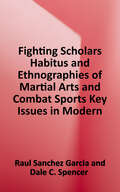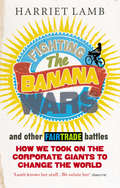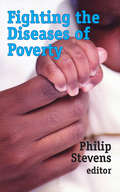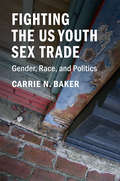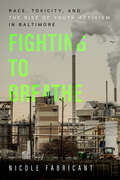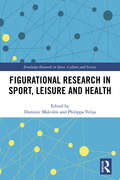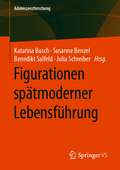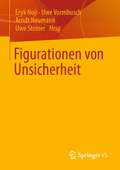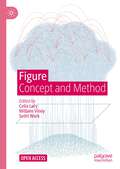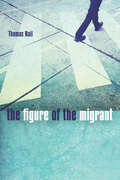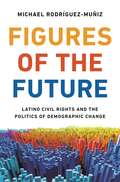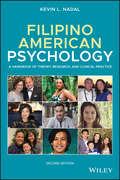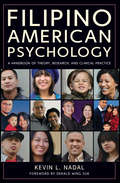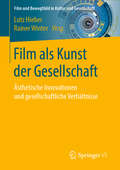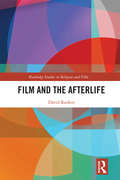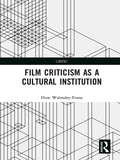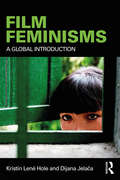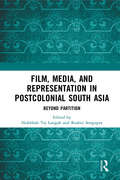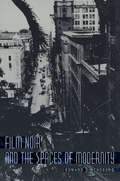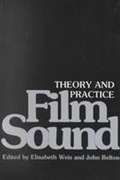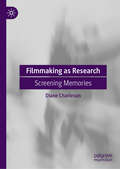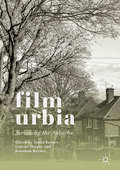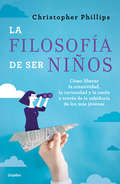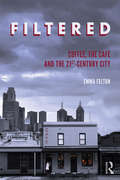- Table View
- List View
Fighting Scholars: Habitus and Ethnographies of Martial Arts and Combat Sports (Key Issues In Modern Sociology Ser.)
by Raul Sanchez Garcia Dale C. SpencerFighting Scholars brings to the fore the ethnographic study of combat sports and martial arts as a means of exploring embodied human existence. The book's main claim is that such activities represent privileged grounds to access different social dimensions, such as emotion, violence, pain, gender, ethnicity and religion. To explore these dimensions, the concept of 'habitus' is presented prominently as an epistemic remedy for the academic distant gaze of the effaced academic body. The different contributions of this volume are aligned within the same project that began to crystallize in Loïc Wacquant's 'Body and Soul': the construction of a 'carnal sociology' that constitutes an exploration of the social world 'from' the body. The book is divided into three sections. In the first section, the editors introduce the field, providing a typology of existing literature. The second section contains the contributions of the authors, discussing their respective approaches to embodied ethnography, their use of the concept of 'habitus', and ethnographic findings. The third section contains a conclusion by the editors - reflecting on existing conceptions of 'habitus' and interdisciplinary possibilities for rethinking the concept - and an epilogue by Loïc Wacquant critically assessing the whole volume.
Fighting the Banana Wars and Other Fairtrade Battles
by Harriet LambIt started very small and full of hope. But its daring campaigns have placed Fairtrade goods at the heart of the supermarket shelves. From bananas and coffee beans to cotton and chocolate, Fairtrade has grown to become an important global movement that has revolutionised the way we shop.As Harriet Lamb, Chief Executive of Fairtrade International, explains in this extensively revised and updated edition of her inspirational book, Fairtrade is about a better deal for workers and famers in the developing world. It's about making sure the food on our plates, and shirts on our backs, don't rob people in other countries of the means to feed or clothe themselves. She explores the journey, through an often unjust system, that Fairtrade items make from farm to consumer. And she uncovers the shocking cost of our demand for cheaper food.There is much still to be done. But by hard work and high ideals, Fairtrade is starting to transform the lives of over 7 million farmers, workers and their families, and is a powerful symbol of how extraordinary change can be achieved against all the odds - by us all.
Fighting the Diseases of Poverty
by Philp StevensPublic discussion of global healthcare issues is dominated by those who believe that top-down, government-driven interventions are the solution to the myriad health problems suffered by people in less developed countries. This thinking is responsible for a plethora of harmful policies, ranging from a drive towards socialized healthcare systems, to calls for the centralization and semi-nationalization of pharmaceutical research and development, to impractical but grandiose UN-sponsored schemes for tackling HIV/AIDS and malaria.In spite of the abysmal track record of top-down approaches, non-governmental organizations and UN agencies continue to promote them, to the detriment of the private sector, economic development, and human health. The resulting politicization of diseases such as HIV/AIDS has led to a diversion of resources away from more easily treatable diseases that affect more people. Meanwhile, cost-effective and simple interventions such as vaccination are being subordinated to other more politically correct diseases.This centralizing mindset has also resulted in many governments in less developed countries attempting to plan and control universal healthcare systems, which has encouraged rationing, inequitable access, and entrenched corruption. It has also seriously undermined the effectiveness of overseas development aid. Moreover, the politicization of diseases such as HIV/AIDS has led to a diversion of resources away from more easily treatable diseases that affect more people. As a result, cost-effective and simple interventions are neglected by donors.There has to date been little public discussion of the role of markets and their underlying institutions--property rights and the rule of law--in improving human health. Economic growth and globalization has led to unprecedented improvements in human health. The challenge is to enable the poorest countries to take part more fully in this process. This work demonstrates how current
Fighting the US Youth Sex Trade: Gender, Race, and Politics
by Carrie N. BakerCampaigns against prostitution of young people in the United States have surged and ebbed multiple times over the last fifty years. Fighting the US Youth Sex Trade: Gender, Race, and Politics examines how politically and ideologically diverse activists joined together to change perceptions and public policies on youth involvement in the sex trade over time, reframing 'juvenile prostitution' of the 1970s as 'commercial sexual exploitation of children' in the 1990s, and then as 'domestic minor sex trafficking' in the 2000s. Based on organizational archives and interviews with activists, Baker shows that these campaigns were fundamentally shaped by the politics of gender, race and class, and global anti-trafficking campaigns. The author argues that the very frames that have made these movements so successful in achieving new laws and programs for youth have limited their ability to achieve systematic reforms that could decrease youth vulnerability to involvement in the sex trade.
Fighting to Breathe: Race, Toxicity, and the Rise of Youth Activism in Baltimore (California Series in Public Anthropology #54)
by Nicole FabricantIndustrial toxic emissions on the South Baltimore Peninsula are among the highest in the nation. Because of the concentration of factories and other chemical industries in their neighborhoods, residents face elevated rates of lung cancer and other respiratory illnesses in addition to heart attacks, strokes, and cardiovascular disease, all of which can lead to premature death. Fighting to Breathe follows a dynamic and creative group of high school students who decided to fight back against the race- and class-based health disparities and inequality in their city. For more than a decade, student organizers stood up to unequal land use practices and the proposed construction of an incinerator and instead initiated new waste management strategies. As a Baltimore resident and activist-scholar, Nicole Fabricant documents how these young organizers came to envision, design, and create a more just and sustainable Baltimore.
Figurational Research in Sport, Leisure and Health (Routledge Research in Sport, Culture and Society)
by Dominic Malcolm Philippa VelijaFigurational sociology offers an important set of conceptual and methodological tools for helping us to understand sport, leisure and health and their relationship to wider society. This book brings together an international team of scholars working within the figurational tradition to explain the significance of figurational sociology in the development of the sociology of sport and to provide empirical case studies of figurational sociology in action. Covering core concepts such as the civilizing process, and key methods such as interviewing and ethnography, the book presents contemporary research in areas as diverse as sport-related health, mixed martial arts, sports policy, gender relations and cycling. Figurational Research in Sport, Leisure and Health is an important resource for students of sport and social sciences, sociology, figurational sociology and sociology of sport and exercise.
Figurationen spätmoderner Lebensführung (Adoleszenzforschung #10)
by Katarina Busch Susanne Benzel Benedikt Salfeld Julia SchreiberDer Band versammelt Beiträge, die sich dem Konnex von Psyche und Gesellschaft widmen, wie er auch im Zentrum der Arbeiten von Benigna Gerisch und Vera King steht. Anhand unterschiedlicher Themen wie Adoleszenz, Migration, Alter, Geschlecht und Generationenverhältnisse werden verschiedene Dimensionen spätmoderner Lebensführung beleuchtet. Übergreifend wird so der Frage nachgegangen, wie das Ineinandergreifen von psychischen und sozialen Dynamiken untersucht und verstanden werden kann.
Figurationen von Unsicherheit
by Eryk Noji Uwe Vormbusch Arndt Neumann Uwe SteinerJede Zeit, jede Gesellschaft kennt ihre eigenen Figurationen von Unsicherheit. Der Band fragt nach den historisch variablen Strategien, Mechanismen und Kulturtechniken, mittels derer Gesellschaften Unsicherheiten thematisieren und bearbeiten. Solche Praktiken sind keineswegs durchgängig auf Unsicherheitsvermeidung bzw. -absorption ausgerichtet. Vielmehr existieren Strategien der Erzeugung und der Absorption von Unsicherheit parallel und verweisen aufeinander. Dieser Diagnose versuchen die interdisziplinären Perspektiven, die dieser Band versammelt, Rechenschaft zu tragen. Geschichtswissenschaften, Literatur- und Medienwissenschaften, Philosophie, Psychologie, Soziologie – sie alle haben eigene Zugänge zum Phänomen der Unsicherheit. Dies zeigt sich auch in der Bandbreite der hier verhandelten Themen: das Entscheiden und Nicht-Entscheiden, Algorithmen und Prognosen, Prävention und Fiktion, Erfahrungsgeschichte, Emotionen und politische Repräsentation, Self-Tracking, Bewertung und Lernen.
Figure: Concept and Method
by Celia Lury William Viney Scott WarkThis open access book shows how figures, figuring, and configuration are used to understand complex, contemporary problems. Figures are images, numbers, diagrams, data and datasets, turns-of-phrase, and representations. Contributors reflect on the history of figures as they have transformed disciplines and fields of study, and how methods of figuring and configuring have been integral to practices of description, computation, creation, criticism and political action. They do this by following figures across fields of social science, medicine, art, literature, media, politics, philosophy, history, anthropology, and science and technology studies. Readers will encounter figures as various as Je Suis Charlie, #MeToo, social media personae, gardeners, asthmatic children, systems configuration management and cloud computing – all demonstrate the methodological utility and contemporary relevance of thinking with figures. This book serves as a critical guide to a world of figures and a creative invitation to “go figure!”
The Figure of the Migrant
by Thomas NailThis book offers a much-needed new political theory of an old phenomenon. The last decade alone has marked the highest number of migrations in recorded history. Constrained by environmental, economic, and political instability, scores of people are on the move. But other sorts of changes--from global tourism to undocumented labor--have led to the fact that to some extent, we are all becoming migrants. The migrant has become the political figure of our time. Rather than viewing migration as the exception to the rule of political fixity and citizenship, Thomas Nail reinterprets the history of political power from the perspective of the movement that defines the migrant in the first place. Applying his "kinopolitics" to several major historical conditions (territorial, political, juridical, and economic) and figures of migration (the nomad, the barbarian, the vagabond, and the proletariat), he provides fresh tools for the analysis of contemporary migration.
Figures of the Future: Latino Civil Rights and the Politics of Demographic Change
by Michael Rodríguez-MuñizAn in-depth look at how U.S. Latino advocacy groups are using ethnoracial demographic projections to bring about political change in the presentFor years, newspaper headlines, partisan speeches, academic research, and even comedy routines have communicated that the United States is undergoing a profound demographic transformation—one that will purportedly change the “face” of the country in a matter of decades. But the so-called browning of America, sociologist Michael Rodríguez-Muñiz contends, has less to do with the complexion of growing populations than with past and present struggles shaping how demographic trends are popularly imagined and experienced. Offering an original and timely window into these struggles, Figures of the Future explores the population politics of national Latino civil rights groups.Based on eight years of ethnographic and qualitative research, spanning both the Obama and Trump administrations, this book investigates how several of the most prominent of these organizations—including UnidosUS (formerly NCLR), the League of United Latin American Citizens, and Voto Latino—have mobilized demographic data about the Latino population in dogged pursuit of political recognition and influence. In census promotions, get-out-the-vote campaigns, and policy advocacy, this knowledge has been infused with meaning, variously serving as future-oriented sources of inspiration, emblems for identification, and weapons for contestation. At the same time, Rodríguez-Muñiz considers why these political actors have struggled to translate this demographic growth into tangible political gain and how concerns about white backlash have affected how they forecast demographic futures.Figures of the Future looks closely at the politics surrounding ethnoracial demographic changes and their rising influence in U.S. public debate and discourse.
Filipino American Psychology: A Handbook of Theory, Research, and Clinical Practice
by Kevin L. NadalDISCOVER THE FOUNDATIONS AND NUANCES OF TREATING THE MENTAL HEALTH OF FILIPINO AMERICANS Filipino American Psychology: A Handbook of Theory, Research, and Clinical Practice, 2nd Edition compiles the latest and best information about the psychology of Filipino Americans into a single, indispensable volume. Distinguished and celebrated professor and author, Dr. Kevin Nadal, explains in thorough detail the mental health issues facing many Filipino Americans today. It also covers effective techniques and strategies for working with the Filipino American population today. Filipino American Psychology uses reader-friendly language, along with numerous vignettes and case studies, to make accessible its in-depth treatment of the subject. The book covers a wide range of topics necessary to understand how to provide mental health treatment to Filipino Americans, including: Filipino and Filipino American Cultural Values Overcoming the Model Minority: Contemporary experiences of Filipino Americans Intersections of Gender and Sexual Orientation Multiracial and Multiethnic Filipino Americans Mental Health and Psychotherapy in the Filipino American community The book also includes a brand-new section on the historical traumas that still reverberate through the Filipino American community. Perfect for mental health practitioners and students who are likely to encounter this large cultural and ethnic group, Filipino American Psychology serves as a foundational volume in any complete mental health library.
Filipino American Psychology
by Kevin L. NadalPraise for Filipino American Psychology: A Handbook of Theory, Research, and Clinical Practice "Filipino American Psychology: A Handbook of Theory, Research, and Clinical Practice is destined to make a major contribution to the field of Asian American psychology and to the larger field of multicultural psychology. " -From the Foreword by Derald Wing Sue, PhD Professor of Psychology and Education, Teachers College, Columbia University "Dr. Nadal has done a superb job of locating the experiences of Filipino Americans within the larger scholarship on ethnic minority psychology, while also highlighting the complexity, richness, and uniqueness of their psychological experiences. This book should be a part of everyone's library. " -E. J. R. David, PhD Assistant Professor, Department of Psychology, University of Alaska Anchorage "Ranging from historical contexts to present-day case studies, theoretical models to empirical findings, self-reflection activities to online and media resources, Filipino American Psychology will engage, stimulate, and challenge both novices and experts. Without question, Dr. Nadal's book is a foundational text and a one-stop resource for both the Filipino American community and the community of mental health professionals. " -Alvin N. Alvarez, PhD Professor, San Francisco State University A landmark volume exploring contemporary issues affecting Filipino Americans, as well as the most successful mental health strategies for working with Filipino American clients Addressing the mental health needs of the Filipino American population-an often invisible, misunderstood, and forgotten group-Filipino American Psychology provides counselors and other mental health practitioners with the knowledge, awareness, and skills they can use to become effective and culturally competent when working with their Filipino American clients. Filipino American Psychology begins by looking at the unique cultural, social, political, economic, and mental health needs of Filipino Americans. Noted expert-and Filipino American-Kevin Nadal builds on a foundational understanding of the unique role and experience of Filipino Americans, offering strategies for more effective clinical work with Filipino Americans in a variety of settings. A must-read for mental health professionals as well as educators and students in the mental health field, Filipino American Psychology is an insightful look at the Filipino American community and the nuances of the Filipino American psyche.
Filipinos in Canada
by Bonnie Mcelhinny John Paul Catungal Lisa M. Davidson Ethel Tungohan Roland Sintos ColomaThe Philippines became Canada's largest source of short- and long-term migrants in 2010, surpassing China and India, both of which are more than ten times larger. The fourth-largest racialized minority group in the country, the Filipino community is frequently understood by such figures as the victimized nanny, the selfless nurse, and the gangster youth. On one hand, these narratives concentrate attention, in narrow and stereotypical ways, on critical issues. On the other, they render other problems facing Filipino communities invisible.This landmark book, the first wide-ranging edited collection on Filipinos in Canada, explores gender, migration and labour, youth spaces and subjectivities, representation and community resistance to certain representations. Looking at these from the vantage points of anthropology, cultural studies, education, geography, history, information science, literature, political science, sociology, and women and gender studies, Filipinos in Canada provides a strong foundation for future work in this area.
Film als Kunst der Gesellschaft: Ästhetische Innovationen und gesellschaftliche Verhältnisse (Film und Bewegtbild in Kultur und Gesellschaft)
by Lutz Hieber Rainer WinterDer Band beschäftigt sich mit dem Kunstbegriff im Hinblick auf Film, wobei es sowohl um ästhetische Theorie als auch um konkrete Werke geht. Das Spektrum umfasst Spielfilme und Dokumentarfilme. Dabei liegt der Schwerpunkt auf den ästhetischen Innovationen des Mediums im Laufe seiner Geschichte und in der Gegenwart. Die Entwicklung visueller Ideen wird auf den historischen und gesellschaftlichen Kontext ihrer Entstehung und Rezeption bezogen. In den Blick geraten Filmautoren, Filmkünstler und Filmbewegungen, die nicht nur im Independent-Film, sondern auch im Mainstream zu finden sind.
Film and the Afterlife (Routledge Studies in Religion and Film)
by David RankinThis book explores how post-death existence is represented in popular film, looking at issues such as continuity, personal identity, and the nature of existence beyond the grave. Film often returns to the theme of dying, death and the afterlife, both directly and indirectly, because there are very few subjects as compelling and universal. The book compares the representation of death, dying and the afterlife in films to scholarly surveys of attitudes towards life-after-death through the analysis of twenty films made between the end of World War II and now. It looks at the portrayals of stages between death and a final destination; spatio-temporal and personal continuity; the nature of afterlife existence in terms of embodiment, or not; and the contact between the worlds of the living and the dead. This book offers a wide-ranging view on a compelling subject in film. As such, it will be of great interest to scholars of Religion and Film, Religion and Media, the Philosophy of Religion, and the Sociology of Religion, as well as Religion, Media and Film Studies more generally .
Film Criticism as a Cultural Institution: Crisis And Continuity From The 20th To The 21st Century (CRESC)
by Huw Walmsley-EvansAt the beginning of the 21st century film criticism was described as in crisis. The decline of print journalism, a series of lay-offs of prominent critics, and the rise of "amateur" reviewing online spurred a conversation about the decline, even death, of film criticism. This discourse flourished in part because film criticism has been little examined in scholarship to date. This book takes a deeper look at film criticism by focusing on its institutional contours. This is achieved through a combination of archival research and interviews with prominent film critics and stakeholders, including Adrian Martin (LOLA), Stephanie Zacharek (Time), Peter Bart (Variety), and Andrew Sarris (The Village Voice). Film Criticism as a Cultural Institution first examines the contemporary crisis conversation surrounding film criticism, comparing this to historical precedents. It then provides what today’s crisis conversation does not: an account of film criticism’s institutional formations. Using primarily U.S. and Australian case studies based on interviews, observation and archival research—as well as accounts from other national schools—the book maps contemporary film criticism. Across various sites, such as publications or online spaces, and organisations, such as film critics circles, it elucidates film criticism’s institutional practices, tasks, comportments, and personae. Looking at the history of conversations about film criticism shows us that "crisis" has always been a leitmotif. While acknowledging the considerable changes and challenges that film criticism faces today, this book situates these within an historical context and proposes an institutional framework that allows us to move beyond crisis discourse. Looking at film criticism in this way allows us to see that the very question of what counts as film criticism is continually contested within an institutional ecology made up of distinctive critical comportments addressed to distinctive audiences.
Film Feminisms: A Global Introduction
by Kristin Lené Hole Dijana Jelača<p>Film Feminisms offers a global and updated overview of the history, present-day concerns, and future of feminist film and theory. It introduces frameworks from phenomenology, affect theory, and psychoanalysis to reception studies, new media theories, and critical historiography, as well as engaging with key issues in documentary ethics, genre theory, and star studies. <p>This new textbook situates feminist film theory within the larger framework of transnational scholarly approaches, as well as decolonial, queer, disability studies, and critical race theories. It offers a much-needed update on pedagogical approaches to feminist film studies, providing discussions of filmmakers and films that have been overlooked in the field, or that are overdue for further analysis. <p>Each chapter is supported by a variety of pedagogical features including activities, key terms, and case studies. Many of the activities draw on contemporary digital media, such as social media and streaming platforms, to update the field to today's changing media landscape.</p>
Film, Media and Representation in Postcolonial South Asia: Beyond Partition
by Nukhbah Taj LangahThis volume brings together new studies and interdisciplinary research on the changing mediascapes in South Asia. Focusing on India, Pakistan, and Bangladesh, it explores the transformations in the sphere of cinema, television, performing arts, visual cultures, cyber space and digital media, beyond the traumas of the partitions of 1947 and 1971. Through wide-ranging essays on soft power, performance, film, and television; art and visual culture; and cyber space, social media, and digital texts, the book bridges the gap in the study of the postcolonial and post-Partition developments to reimagine South Asia through a critical understanding of popular culture and media. The volume includes scholars and practitioners from the subcontinent to foster dialogue across the borders, and presents diverse and in-depth studies on film, media and representation in the region. This book will be useful to scholars and researchers of media and film studies, postcolonial studies, visual cultures, political studies, partition history, cultural studies, mass media, popular culture, history, sociology and South Asian studies, as well as to media practitioners, journalists, writers, and activists.
Film Noir and the Spaces of Modernity
by Edward DimendbergFilm noir remains one of the most enduring legacies of 1940s and '50s Hollywood. Populated by double-crossing, unsavory characters, this pioneering film style explored a shadow side of American life during a period of tremendous prosperity and optimism. Edward Dimendberg compellingly demonstrates how film noir is preoccupied with modernity--particularly the urban landscape. The originality of Dimendberg's approach lies in his examining these films in tandem with historical developments in architecture, city planning, and modern communications systems. He confirms that noir is not simply a reflection of modernity but a virtual continuation of the spaces of the metropolis. He convincingly shows that Hollywood's dark thrillers of the postwar decades were determined by the same forces that shaped the city itself. Exploring classic examples of film noir such as The Asphalt Jungle, Double Indemnity, Kiss Me Deadly, and The Naked City alongside many lesser-known works, Dimendberg masterfully interweaves film history and urban history while perceptively analyzing works by Raymond Chandler, Edward Hopper, Siegfried Kracauer, and Henri Lefebvre. A bold intervention in cultural studies and a major contribution to film history, Film Noir and the Spaces of Modernity will provoke debate by cinema scholars, urban historians, and students of modern culture--and will captivate admirers of a vital period in American cinema.
Film Sound: Theory and Practice
by Elisabeth Weis John Belton B. WeissThis classic anthology provides essential models for analyzing sound stylistics through the detailed study of critical sound films. Elisabeth Weis and John Belton carefully curate major essays from the world's most respected film historians, aestheticians, and theorists, including Douglas Gomery, Barry Salt, Rick Altman, Mary Ann Doane, S. M. Eisenstein, V. I. Pudovkin, René Clair, Béla Belázs, Siegfried Kracauer, Christian Metz, David Bordwell, Kristin Thompson, Noël Burch, and Arthur Knight. Their selections recount the innovations and triumphs of Ernst Lubitsch, Fritz Lang, Orson Welles, Alfred Hitchcock, Rouben Mamoulian, Dziga Vertov, Robert Bresson, Jean-Luc Godard, Robert Altman, and Francis Ford Coppola, among many others, and explicate the techniques and practices of sound filmmaking from initial recordings to final theater playback. Film Sound is the ideal companion for anyone seeking both a comprehensive introduction to the form and a rich survey of its historical and global evolution.
Filmmaking as Research: Screening Memories
by Diane CharlesonThis book examines the challenges often experienced by film practitioners who find themselves researching within the academy, either as students or academics. In light of this the author presents her own journey from practitioner to researcher as a lens. Her practice- based research has been a quest to ”revision” memories, by creating filmic images that elicit memory and remembering. In so doing she has used a range of platforms: multi- screen video installation, still- framing the moving image and remixing found footage. Central to this research has been the importance of family storytelling and sharing, the relationship of the visual and memory, the agency of nostalgia and the role of aura, particularly evident in the re-appropriating of super 8 home movies into a variety of forms. Important to this is has been the relationship of the viewer and the viewed in particular the role of an immersive environment of viewing.
Filmurbia
by David Forrest Graeme Harper Jonathan RaynerIn this book, scholars from across the world explore the appearance, portrayal and significance of the suburb on film. By the mid-20th Century, supported by changes in transportation, suburbs became the primary location of entire national populations and films about the suburbs began to concertedly reflect those suburbs' significance as well as their increasingly lively cultures! Suburbia very soon became filmurbia, as films of the suburbs and those made in the suburbs reflected both the positive and the negative aspects of burgeoning suburban life. Film-makers explored the existences of new suburbanites, their interests, their newly emerging neighbourhood practices, their foibles, their fantasies and their hopes. Whether depicting love, ambition, commerce, family, home or horror, whether traveling to or living in suburban spaces, whether exhibiting beauty, brazenness or brutality, the films of suburbia capture human life in all its diverse guises.
La filosofía de ser niños
by Christopher PhillipsCómo liberar la creatividad, la curiosidad y la razón a través de la sabiduría de los más jóvenes. La niñez es nuestra plataforma de despegue, el periodo de la vida en el que el aprendizaje es más intenso, y adquirimos el conocimiento crítico y las habilidades que nos permitirán adaptarnos. Filósofos de todas las épocas han señalado que, con el paso del tiempo, los seres humanos tendemos a encogernos mental y emocionalmente. Desvirtuamos nuestra naturaleza -caracterizada por la curiosidad, la empatía, la razón, el asombro y el deseo de experimentar y entender- y, de esta manera, se va volviendo borroso nuestro sentido de identidad. Comenzamos nuestras vidas con un estallido moral, intelectual y creativo. Siguiendo las evidencias científicas que así lo demuestran, Christopher Phillips advierte que la niñez no es simplemente un estado de desarrollo, de transformación -de llegar a ser-, ni la adultez un momento de plenitud o acabamiento. Si aprovechamos las cualidades propias de la niñez, no estaremos condenados a volvernos seres desanimados y frágiles, sino que creceremos y viviremos guiados por el asombro, la curiosidad, la imaginación, el sentido de juego y la compasión. Explorando y explotando la filosofía de ser niños, podremos desarrollar ilimitadamente nuestro potencial. Vinculando filosofía, ciencias sociales, investigación neurocientífica y anécdotas personales, este libro propone una aproximación radicalmente distinta al tema de la frontera entre niñez y adultez, para mostrarnos que la forma como los niños ven y viven el mundo puede ser una clave para un desarrollo pleno, para alcanzar eso que los griegos llamaban areté o excelencia.
Filtered: Coffee, the Café and the 21st-Century City
by Emma FeltonCafé culture is flourishing in cities across the world. From London to Seoul, Melbourne to Shanghai and many cities in between, people are flocking to cafés. A recent phenomenon, café culture has made its reappearance only since the end of the 20th century. What is the appeal of the café for urban dwellers? And why now? ‘Having a coffee’ might be a daily ritual, yet it is more than coffee that draws us to the café. Cafés are vital social spaces, technically connected workspaces, and businesses that are forging design and food trends. The café is the lens through which this book explores major changes occurring in everyday life in cities across the world. Urban regeneration has fuelled the growth of urban amenity and social consumer spaces. The impact of technology, social and workplace transformation, and the ascendency of the design and food industries all find expression in the spaces of the cafe. The specialty coffee movement is a thriving, global presence, uniting café staff and customers across geographical borders, with a shared commitment to the connoisseurship of coffee. In the book’s global sweep, it examines the development of café culture in China, Japan and Australia as significant and interesting departures from traditional European café culture. Australia is a world leader and successful exporter of its unique style of coffee and food. Interviews with café patrons and staff illuminate why the café has become a meaningful place for many people in the 21st-century city.
